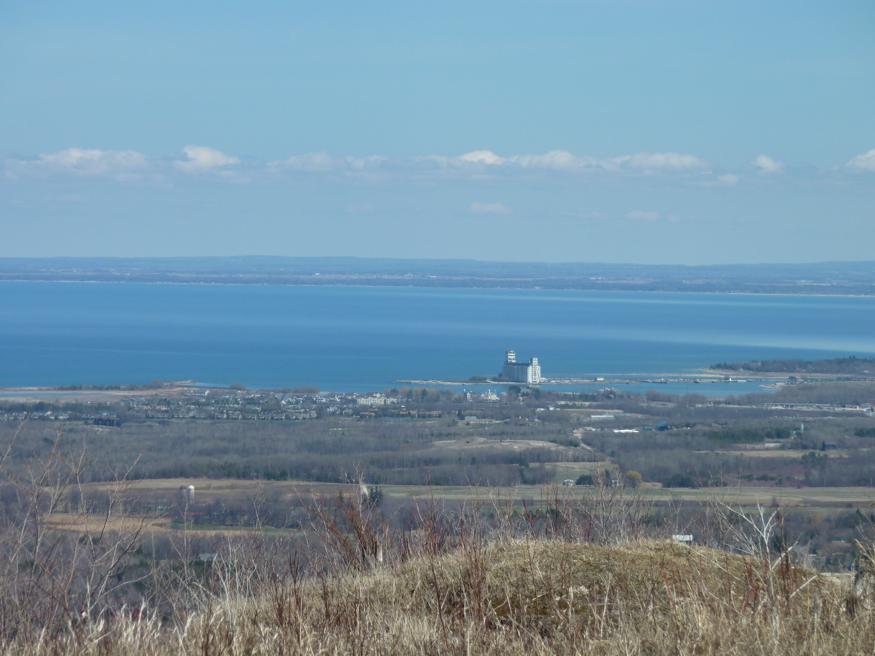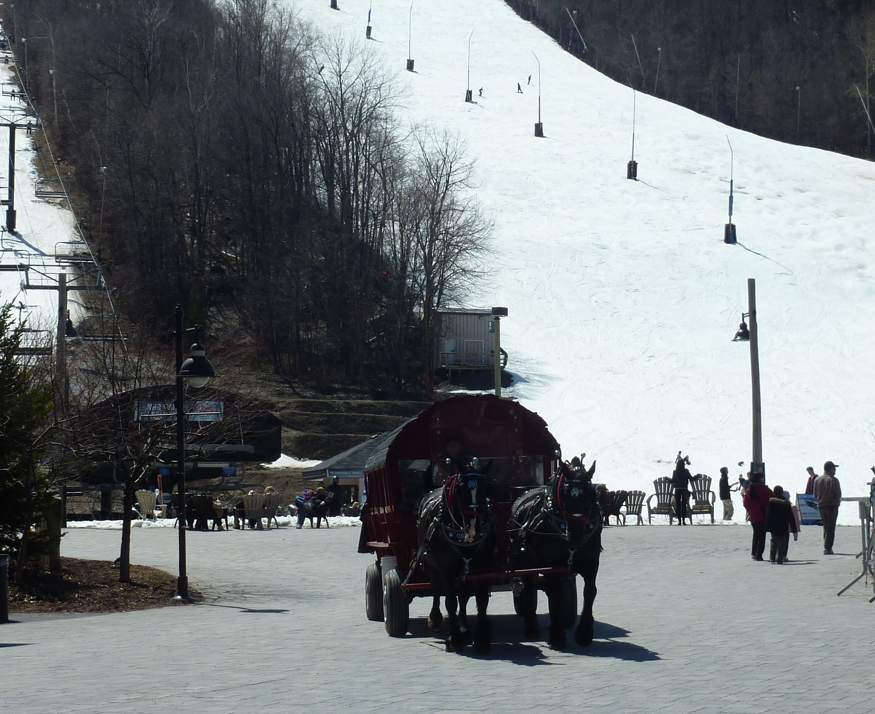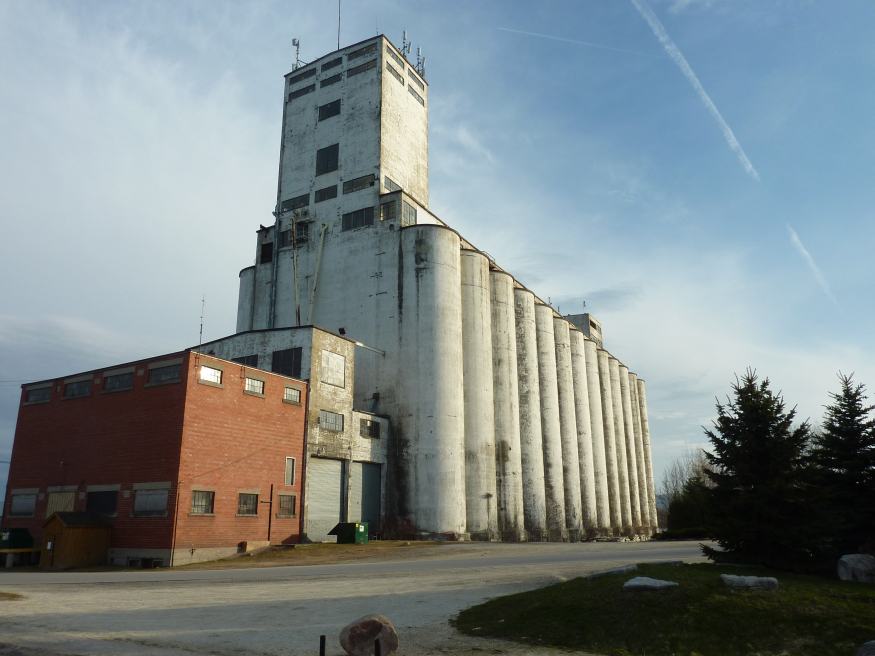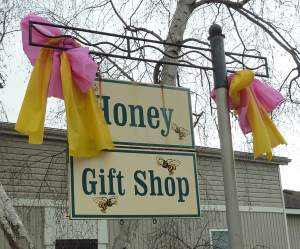This beautiful area of Ontario on the southern shores of Georgian Bay, about a 2 hour drive north of Toronto, was a great place to spend Easter. Staying in a comfortable condo just outside of Collingwood offered us a central location for exploring the area. The condo was courtesy of my mother who traded in some of her timeshare credits for a week there and invited the family.
My memories of the Collingwood area centered around the Blue Mountain Resort*, where I skied as a kid. It is also a great summer vacation area with plenty of sun, beaches and wonderful natural areas to explore. Situated on the Niagara Escarpment, there are incredible views and many trails, such as the Bruce Trail*, winding its way through the area on its 560 mile journey from Tobermory to Niagara Falls along the edge of the Niagara Escarpment. The Niagara Escarpment is designated by UNESCO as a World Biosphere with towering cliffs, aquatic ecosystems, ancient cedars and rare plant life.
Collingwood played a key role in the history of the Great Lakes. It was once home to a major ship building industry and a port for literally all the grain shipped across Canada to the rest of the world. At one point, it was promoted as the “Chicago of the North” and had a United States Consulate to help handle the freight and passenger traffic between American ports and Canada. The massive grain elevator used to transfer grain from ship to rail is still there, a testimony to the grain trade and the massive lakers and railway used to transport it.

View from the top of Blue Mountain ski area looking NE over Collingwood, Collingwood harbor and Georgian Bay. The grain elevator is the large structure.

Looking back at Blue Mountain from just beside the grain elevator shown in the photo above. The ski runs are still snow-covered although they only had a few open today.

One of the shop-filled streets in Blue Mountain village. A lively spot for skiers and travelers alike. Plenty of restaurants, pubs and shops.

A horse-drawn wagon full of people meanders through the village. We sit outside listening to live music, watching the skiers and enjoying a beer and food.

The grain elevator is on the spit that forms the eastern breakwater of Collingwood harbor. The scale of the structure is hard to describe. It is truly gigantic!
From the information kiosk beside the elevator:
” …The Collingwood grain elevators have dominated the harbourfront since 1854 and have served as a symbol of Collingwood’s imporance as a supplier of grain throughout the world. Prior to 1854 surplus grain reached markets only after long and often impossible routes… …The last railroad car was loaded at the elevator in 1986. The spit had space for 70 cars, each holding 100 tons of grain… …The cement elevator (seen here), built in 1929… …had a capacity of 2,000,000 bushels of grain and the ability to handle up to 30,000 bushels an hour…”
Visualizing 114,000 Tons of Honey
My mind boggles when I think of the amount of honey produced by the billions of bees around the world. I’ve never been able to visualize the yearly world production of honey of around 1.3 million tons. What if the grain elevator was re-purposed as a honey vat? How much honey would it hold?
The volume of two million bushels of grain is about 72,000,000 liters and a liter of honey weighs about 3.17 pounds. If the silos were filled with honey rather than grain, they would hold about 114,000 tons of honey! Therefore the annual world production of 1.3 million tons would fill 11 Collingwood grain elevators (CGE)! As large as they are, that doesn’t seem like so much for the entire world’s production. By the way, one “CGE” is approximately equal to the entire 2010 honey production of both Canada and the United States!
Show me the Honey!
 As we walked along the main street of Collingwood I noticed a shop called, Wheat & Honey Natural Health Foods. Naturally I checked it out. I hoped to learn more about the local honey and I wasn’t disappointed. They had a small selection of honey including a jar of “Beaver Valley Gold” from “The Honey House”. The Honey House was a short drive away in Clarksburg just west of Collingwood. I bought the jar shown here and got directions. Unfortunately they thought it was probably closed, only being open later in the week this time of the year—we would be headed back home before then… Nevertheless, the Clarksburg area seemed as good a target as any for our exploratory drive the next day. Our resolve was sweetened once we tasted the honey—it was delicious! If you look carefully you can see we had eaten more than half the jar by the time the photo was taken a couple of days later!
As we walked along the main street of Collingwood I noticed a shop called, Wheat & Honey Natural Health Foods. Naturally I checked it out. I hoped to learn more about the local honey and I wasn’t disappointed. They had a small selection of honey including a jar of “Beaver Valley Gold” from “The Honey House”. The Honey House was a short drive away in Clarksburg just west of Collingwood. I bought the jar shown here and got directions. Unfortunately they thought it was probably closed, only being open later in the week this time of the year—we would be headed back home before then… Nevertheless, the Clarksburg area seemed as good a target as any for our exploratory drive the next day. Our resolve was sweetened once we tasted the honey—it was delicious! If you look carefully you can see we had eaten more than half the jar by the time the photo was taken a couple of days later!
The next afternoon we headed to Clarksburg, actually located in Beaver Valley, and as feared, the Honey House was closed! Not to be daunted, I crossed the road to the post office and asked the helpful gal behind the counter if the owners were available. After some investigation and some help from a local resident we found the phone number and were able to arrange an appointment an hour later!
We were met by Al Lockhart, who with his wife Keri, own the Honey House. Al gave us a tour of his modern and very clean facility where about 20 tons of honey are processed per year from their own hives. The Lockhart’s produce raw honey. This is the only way to retain the aromatic and healthful properties of the honey. This is like eating honey as it comes from the honey comb. In extracting and bottling the honey, its temperature is kept under 95 degrees and it is only strained to remove larger particles. This retains the pollen, enzymes and volatile aromatics vital to the flavor and the healthful benefits of the honey.
Their store was modern and filled with local goods including honey and beeswax products. In addition to more honey, we bought some natural beeswax furniture polish, made by Keri (we later used on our butcher block counter with great success).
While all Al’s honey is made with mainly clover and wildflowers of the season from Beaver Valley and the Meaford area, occasionally a particular flower will predominate and create a unique and special honey. Al speculated that last fall’s honey from one of his hive areas near the “Tank Range”* outside of Meaford contained a large amount of yellow star thistle (Centaurea solstitialis), similar in taste and color to a mild version of clover.
I asked Al about his bees and whether he’d had any problems with CCD (colony collapse disorder). It turns out that last winter’s die off was only around 25%. This is quite good. Al felt that this was because of a varied diet and especially intense management and inspections of his hives. He also attributed his good beekeeping practices partly to the support and education provided by the University of Guelph’s Honeybee Research Center, where Apiculture research and education are internationally renowned. Part of a long beekeeping tradition that started in 1894 when the first beekeeping courses were taught at the Ontario Agricultural College.
To find other bee farms and delicious Ontario honey, check out the Ontario Beekeepers Association Source Directory
There are many unique artisan shops and owner operated restaurants to visit in the area. Here is a small sample of ones we dropped into:
The Stuffed Peasant:
A cozy American restaurant with an eclectic menu. Head chef and owner, Scott Carter created a wonderful meal for the five of us and later chatted about wild edible mushrooms he has found in the area, including a chart of the common species!
206 Hurontario St.
Collingwood Ontario L9Y 2T2
Canada
705.445.6957
The Honey House:
204 Marsh St.
Clarksburg, Ontario N0H 1J0
Canada
519-599-5434
Brochure
Matilda Swanson Gallery:
We found a surprising number of beautiful paintings here. Click on “Paintings” on her website. Or better yet, visit the gallery.
185 Marsh Street
Clarksburg, Ontario N0H 1J0
Canada
https://www.matildaswansongallery.com
Ashanti Coffee Estate:
Who would have expected a coffee shop in this out-of-the-way place to also be the primary roaster and distribution point for their Zimbabwe coffee plantation. As expected, the coffee was superb and the pastries, butter tarts and tea were “lekker” too.
39 Bruce Street South
Thornbury, Ontario N0H 2P0
Canada
https://ashanticoffee.com
The Cheese Gallery:
An eclectic tea, cheese and art framing shop. They distribute a wide variety of Canadian cheeses including goat.
11 Bruce Street South
Thornbury, Ontario N0H 2P0
Canada
https://thecheesegallery.ca
——————————————————————-
*Other Resources:
The Blue Mountains Bruce Trail Club
The Blue Mountain Resort
Tank Range Historical note: Like the grain elevator, the Tank Range was also shut down; deemed unnecessary in the late 1960’s, but was resurrected as one of Canada’s largest military training centers.








Recent Comments